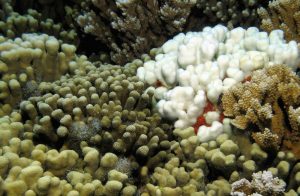UH STUDY: Coral Reefs May Have ‘Thick Skins’ for Climate Change
Coral reefs may have “thicker skins” than previously thought for dealing with warming ocean temperatures caused by climate change.
A new study conducted by scientists at the University of Hawai‘i at Mānoa and the California Academy of Sciences shows the soft tissues that cover coral skeletons can help corals recover from bleaching. These soft tissues house beneficial algae, which provide a source of energy for the corals. Bleaching, or a loss of pigmentation, is caused by a disruption in the symbiotic relationship between algae and coral reefs.
The study, led by Chris Wall, a graduate student at UH Mānoa’s Hawai‘i Institute of Marine Biology (HIMB), shows that corals with thicker tissue may be better equipped to survive bleaching in warming ocean temperatures.
In addition to protecting shorelines from storms and coastal erosion, Hawai‘i’s coral reefs also support the local economy through tourism, diving and recreational fisheries. Under stress, corals can lose the colorful algae living in their tissues, resulting in the bleaching and sometimes death.
Coral bleaching and die-off has been historically rare in the Hawaiian Island. But recently, the effects of climate change on ocean temperatures has become more widespread, resulting in coral bleaching events in 2014 and 2015.
“While we know a great deal about thermal stress and its effects on corals, we know comparatively little about how corals recover from bleaching in the real world, or how local factors, such as light or nutrients in seawater, can influence recovery from bleaching,” said Wall.
During the fall of 2014, Wall and his fellow researchers studies two species of corals: rice coral and finger coral in Kāne‘ohe Bay, O‘ahu. Ocean temperatures reached an unusual high of 86°F during this time—nearly the maximum Hawaiian corals can tolerate. The team of researches wanted to understand how coral colonies that are sensitive to heat stress respond to and recover from bleaching compared to neighboring colonies that remain colored and did not beach. Taking measurements of environmental factors including light levels, water temperatures, sedimentation rates and seawater nutrients helped them better understand how environment factors affect the severity of coral bleaching, and the colony’s recovery. They also assessed what these corals were eating during and after heat stress.
“A coral’s diet is based on food from their symbionts and the consumption of small organisms in seawater known as plankton, and these two sources supply the building blocks for coral tissues,” Wall said. “But under bleaching, corals are left without their symbionts and are in effect starving. We wanted to know how corals overcome this nutritional dilemma—were they relying on stored energy in their tissues (much like a bear in hibernation) or were they eating more plankton?”
The bleached colonies did not die and showed remarkable resilience, recovering from losses in both their symbionts and soft tissues within three months. Their recovery was quickened by facotrs like cooler water temperatures and low nutrient concentrations int he water. Furthermore, the researchers determined that the stored energy in coral tissues—and not an increase in plankton feeding—served as food for corals during thermal stress and helped them recover.
“Kāne‘ohe Bay is a unique coral ecosystem that has rebounded from decades of human impacts. Therefore, corals in Kāne‘ohe Bay may hold valuable lessons for science as we work to understand the basis for coral tolerance to the environmental challenges experienced today and those to come in the future as humans continue to change our global climate,” said Wall.















